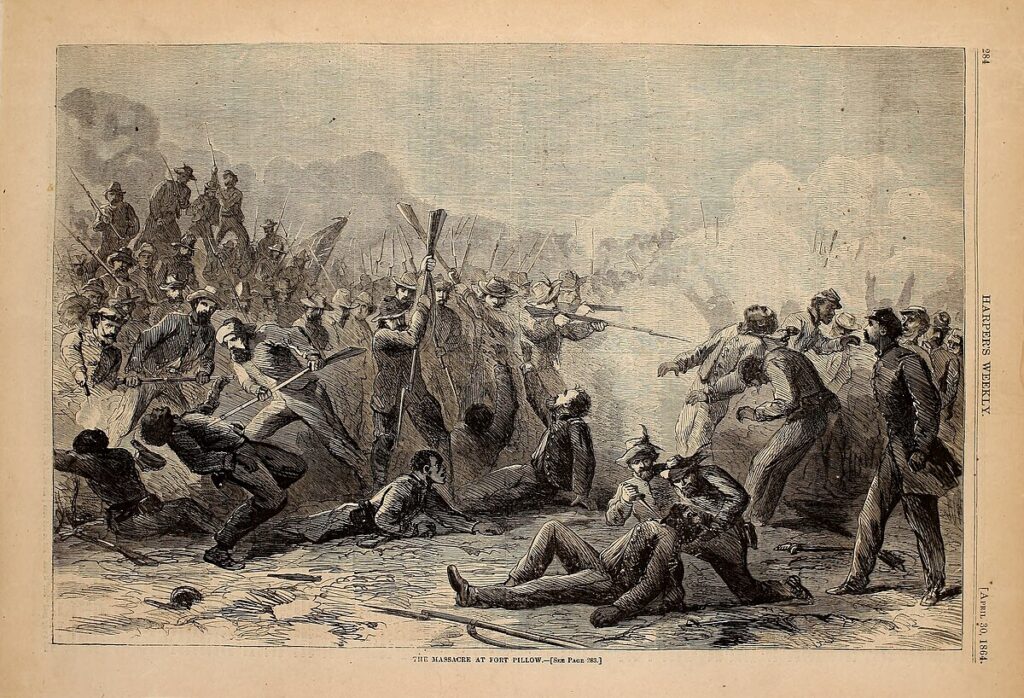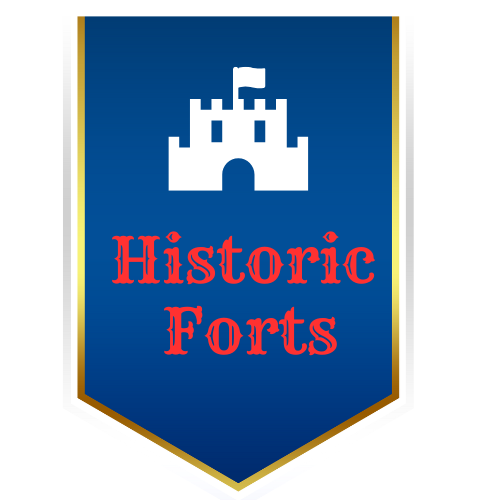Fort Pillow, Tennessee, is pivotal in Civil War history due to its strategic significance and the infamous battle.
This site, located along the Mississippi River, was a focal point for control, making it a hotbed for conflict between Union and Confederate forces.
On April 12, 1864, Fort Pillow became the scene of a brutal massacre when Confederate forces, led by Major General Nathan Bedford Forrest, overran the Union garrison, resulting in the deaths of many African American soldiers.
This event remains a stark reminder of the war’s racial tensions and its profound impact on American history.
History of Fort Pillow (Tennessee)

Fort Pillow was located on the Mississippi River and played a notable role during the American Civil War.
Analyzing its background, strategic importance, and significance reveals its key contributions and pivotal actions.
The American Civil War Background
The American Civil War, which lasted from 1861 to 1865, pitted the North against the South in a battle over slavery and states’ rights.
Tennessee’s strategic location made it a critical area for control. As a Southern state, it provided essential resources and served as a battleground for many significant skirmishes, including those near Fort Pillow.
Strategic Importance of Fort Pillow
Fort Pillow was crucial due to its location along the Mississippi River, north of Memphis. Controlling this fort meant dominating the river, a vital transportation and supply route.
The Confederate and Union forces knew this, leading to intense battles. The fort’s elevated position provided a defensive advantage over the river and surrounding area.
Significance in the Civil War
Fort Pillow is most infamously known for the battle and massacre on April 12, 1864.
Confederate forces attacked and quickly overwhelmed the Union garrison, composed mostly of African American soldiers.
Reports indicated that many Union soldiers were killed even after surrendering, marking a contentious and brutal chapter in Civil War history.
This event highlighted the war’s racial tensions and significantly impacted public perception.
The buildup to the Battle

The events leading up to the Battle of Fort Pillow included notable troop movements, tactical preparations, and specific intentions by Union and Confederate forces.
Key elements of the preparations set the stage for the conflict that unfolded.
Union Troops at Fort Pillow
The Union garrison at Fort Pillow consisted of approximately 600 troops, including a mix of African American soldiers from the United States Colored Troops (USCT) and white soldiers.
This strategic location on the Mississippi River was intended to control river traffic and support Union supply lines.
Commanding the fort, Major Lionel F. Booth initially led the forces until he was killed during the attack.
Following his death, Major William F. Bradford assumed command. The fort’s defenses included earthworks and heavy artillery, but many accounts found the garrison’s overall preparedness and supply levels inadequate.
Confederate Forces and Intentions
Confederate forces, under the command of Major General Nathan Bedford Forrest, planned to capture Fort Pillow as part of a broader campaign to disrupt Union supply lines and reclaim control over key strategic locations in Tennessee and Kentucky.
Forrest’s cavalry numbered around 1,500 men and was known for its highly mobile and aggressive tactics.
Forrest intended to overwhelm the Union garrison through surprise and force.
His reputation as a fierce and effective leader added a psychological edge to the Confederate assault. The capture of the fort was seen as a means to derail Union operations in the region.
Pre-Assault Movements
Before the assault on Fort Pillow, Confederate forces conducted several strategic movements.
Forrest’s cavalry maneuvered through western Tennessee, aiming to exploit Union vulnerabilities.
The force rapidly approached Fort Pillow to catch the Union garrison off-guard.
On April 12, 1864, the Confederates launched their attack. They utilized aggressive skirmishing techniques and artillery bombardment to soften the Union defenses.
Despite warnings and skirmish reports, the Union garrison was in a precarious position due to their inferior numbers and preparation.
The Battle of Fort Pillow

The Battle of Fort Pillow, which took place on April 12, 1864, was marked by a fierce assault by Confederate forces, staunch Union defenses, and significant use of artillery.
Critical events during the battle led to significant casualties, especially among African American soldiers.
Initial Confederate Attack
Confederate forces, led by Major General Nathan Bedford Forrest, launched a surprise attack on Fort Pillow. Arriving before dawn, they swiftly moved to position around the fort.
Confederate Soldiers advanced through the cover of hills and trees, using the terrain to their advantage.
The coordinated assault quickly overwhelmed outer defenses. Confederate sharpshooters targeted key positions, causing heavy damage to Union Soldiers.
The Confederate strategy focused on an aggressive push, exploiting weaknesses in the fort’s structure. Despite some resistance, the initial attack created chaos within Union lines.
Union Defense and Artillery Use
Union forces, including many African American Soldiers, mounted a determined defense.
Despite being outnumbered, they leveraged the fort’s artillery to disrupt Confederate advances.
Artillery pieces were critical in holding back the attackers.
Cannons were strategically placed to cover key approaches, raining fire on Confederate positions. Defensive measures included barricades and trenches, providing temporary relief against the assault.
Union troops sustained heavy losses but managed to inflict casualties on the attackers. The defense bought crucial time but ultimately struggled against the relentless Confederate push.
Major Events of the Battle
As the battle raged, Major General Nathan Bedford Forrest demanded surrender. The Union garrison refused, leading to a final, bloody assault.
Confederate troops stormed the fort, engaging in close-quarters combat.
The final breach resulted in significant Union casualties. Reports indicate that Confederate soldiers showed little mercy, especially against African American troops.
This ferocity added to the high death toll and sparked accusations of a massacre.
Aftermath of the Battle
The Battle of Fort Pillow had significant and brutal consequences. It left behind notable casualties, provoked various reports on the massacre, and substantially influenced public opinion.
Casualties and Prisoners of War
The Battle of Fort Pillow resulted in high casualties, particularly among the United States Colored Troops (USCT) and African American soldiers.
Casualties:
- Union: Estimates suggest around 500 Union soldiers were killed, wounded, or missing.
- Confederate: Confederate casualties were markedly lower, with approximations indicating fewer than 100.
Prisoners of War:
Union soldiers, including African Americans, were reportedly taken as prisoners. However, many accounts indicate that surrendered soldiers were later executed rather than being imprisoned.
Testimonies from survivors highlighted the harsh treatment and high death toll, which was far disproportionate compared to the number of wounded.
Reports on the Massacre
The Fort Pillow Massacre triggered various accounts and investigations, both contemporary and retrospective.
Contemporary Reports:
Reports from Union officers and African American soldiers painted a grim picture. They accused Confederate forces of murdering soldiers who had already surrendered.
Historical Analyses:
Historians have scrutinized these reports, debating the intent and extent of the massacre.
The term “Fort Pillow Massacre” encapsulates the brutal and racially charged nature of the event, with many agreeing that it was a calculated act of aggression towards African American soldiers.
The extent and details of these accounts have been subject to substantial academic study and discourse over the years.
Impact on Public Opinion
The battle’s aftermath profoundly affected public opinion in the North and South.
Northern Reaction:
In the North, the reports of the massacre led to outrage.
The brutal treatment of African American soldiers galvanized support for the Union cause and fueled anti-Confederate sentiment. The event was used as propaganda to justify the Union’s war efforts and the moral imperative to abolish slavery.
Southern Reaction:
Conversely, Southern perspectives often justified the actions taken at Fort Pillow, citing the chaos of battle or denying the extent of the brutality.
The massacre’s differing interpretations further polarized the American populace, influencing the political and military strategies of both sides.
Explore More: Army Forts in Tennessee
Historical Disputes and Analysis
The Fort Pillow battle sparked significant debates among historians, centering on interpretations and controversies. Major General Nathan Bedford Forrest’s role and varying testimonies have further fueled these discussions.
Historian Interpretations
Historians have diverse interpretations of the events at Fort Pillow.
Some view it as a massacre, pointing to the high number of Union casualties, particularly among African American soldiers. Others argue it was a heated battle, not a premeditated slaughter.
Union vs. Confederate Accounts:
- Union: Emphasize atrocities.
- Confederate: Defend actions as a wartime necessity.
The motives behind the attack are frequently scrutinized, reflecting broader tensions and racial issues of the Civil War era.
Controversies Surrounding the Battle
The controversies often revolve around whether the incident was a spontaneous combat scenario or a deliberate massacre.
Reports from both sides were conflicting, adding to the complexity.
Key Points of Debate:
- Casualty Discrepancies: Significant differences in reported numbers.
- Treatment of Surrendering Troops: Varying accounts of how surrendering Union soldiers were treated.
- Racial Factors: The treatment of African American troops remains a critical point of contention.
These debates highlight the difficulties in establishing a singular narrative.
Role of Nathan Bedford Forrest
Nathan Bedford Forrest’s role is central to the discussion. He led the Confederate forces at Fort Pillow, and his actions were subject to intense scrutiny.
Forrest’s Military Tactics:
- Aggressive Strategy: Known for rapid and decisive actions.
- Leadership: His direct involvement raises questions about intent and brutality.
Forrest’s statements following the battle and his controversial later role in the Ku Klux Klan add layers to his historical portrayal.
Testimonies and First-Hand Accounts
Testimonies from survivors and eyewitnesses provide crucial insights and contribute to the conflicting narratives. These accounts include:
Union Soldiers:
- Claimed indiscriminate killing, even of those who surrendered.
Confederate Soldiers:
- Asserted that the Union soldiers continued to fight and resisted capture.
These testimonies vary widely, influenced by the chaos of battle and the perspectives of those involved. Their recounts are essential for understanding the complex dynamics of the Fort Pillow incident.
Explore More: 21 Historic Forts of Tennessee
Modern Commemoration and Legacy
Fort Pillow, Tennessee’s legacy, is preserved and honored through various means, including a dedicated state historic park, numerous memorials, and Initiatives highlighting its historical significance.
Fort Pillow State Historic Park
Fort Pillow State Historic Park serves as a key location for preserving and interpreting the history of the Fort Pillow Massacre.
The park offers visitors a museum with various exhibits, including artifacts and displays detailing the events of the 1864 massacre.
Visitors can also explore well-preserved earthworks and trails offering scenic views.
Educational programs and guided tours are available, enhancing the visitor experience. The park is crucial for anyone looking to gain deeper insights into this significant event in American history.
Memorials and Recognitions
Various memorials have been established to honor those who lost their lives at Fort Pillow. A prominent memorial within Fort Pillow State Historic Park is a testament to the soldiers who perished.
These memorials are often accompanied by plaques or markers that provide historical context.
Several national and state recognitions have been granted outside the park to commemorate the massacre, including its designation as a National Historic Landmark.
Educational Initiatives
Educational initiatives surrounding Fort Pillow play a crucial role in maintaining its legacy.
Schools and universities often include the Fort Pillow Massacre in American history curricula.
This ensures that new generations learn about this pivotal event.
Museums and historical societies also conduct outreach programs and unique presentations.
Several books and documentaries have been produced, providing detailed accounts and analysis.
These efforts help keep the memory of Fort Pillow alive and relevant in contemporary discussions on American history.

Cory is a website owner and content creator who enjoys fishing, history, coin collecting, and sports, among other hobbies. He is a husband and father of four.
Romans 15:4 For whatever was written in former days was written for our instruction, that through endurance and through the encouragement of the Scriptures we might have hope.

